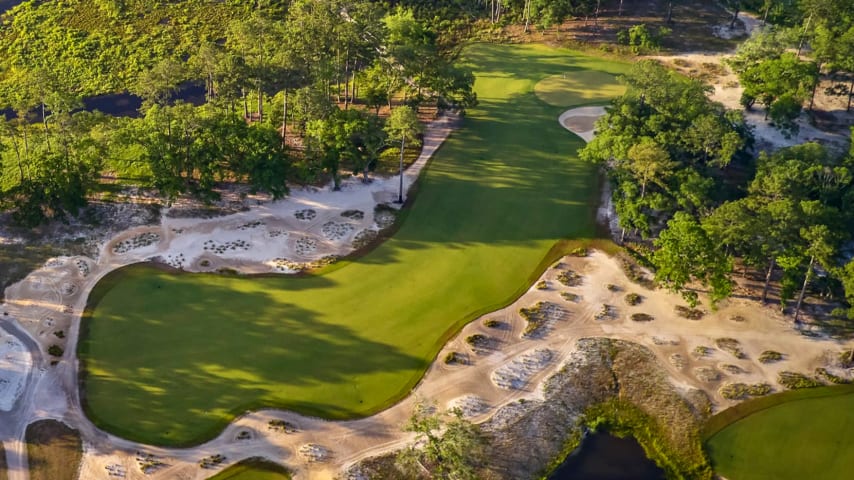Five Things to Know: Congaree Golf Club
8 Min Read

Written by Jeff Eisenband

Flyover: Congaree Golf Club
The PGA TOUR is returning to Congaree Golf Club in South Carolina for the second time in two years, but with a twist. The 2021 Palmetto Championship at Congaree was announced in April of that year. In June, Congaree made its PGA TOUR debut with Garrick Higgo winning by one stroke. The Tom Fazio design, which opened in 2017, jumped in at a moment’s notice.
The CJ CUP will present a different Congaree in October, and Fazio and the team at Congaree, in conjunction with the TOUR, have had time to re-examine how to make this track a beautiful test for the best in the world, many of whom will be seeing Congaree for the first time.
It has a links-like feel
One of the first things that sticks out about Congaree is the sand. Bunkers and waste areas line the fairways and turn greens into peninsulas and patches of rough into archipelagos. To play the course is to recognize this is not a sinking sand, but firm, fertile golf course soil. Inspired by European links courses built on sand, Fazio saw the bones of a compact course in Congaree.
“It plays very firm and fast,” Fazio said. “It's maintained that way for fast speeds. The ball goes far, but also moves a lot on the ground. That can make it strong, especially for this level of play. The greens will be firm and if it gets rain, they'll just shoot a few more birdies.”
Bruce Davidson, Director of Golf at The Friedkin Group, is a native Scotsman and long-time golf instructor. He was among the group originally scouting a location for Congaree. Along with fellow Director of Golf John McNeely, Davidson was tasked with finding a large property for a firm, fast course. They first saw Congaree in 2013 and liked the look of Congaree’s sand.
“It was very reminiscent of Pinehurst No. 2, Pine Valley,” Davidson said. “We thought, no, it can't, we can't be this lucky. I don't know what happened hundreds of millions of years ago right there, but the sea was probably there and left the deposit of sand. It's just remarkable.”
Using sand-capping, Fazio, Davidson and McNeely further firmed up the course. The results are fairways and greens that will keep golf balls moving on the ground, while also bringing in the danger of long bunkers. An errant tee shot can run quickly through the side of the fairway and get caught in the bunker like a gutter ball in bowling. Limited rough on the course provides a limited amount of bailout between the fairways, greens and bunkers.
It features inland beaches
Congaree is 40 miles from Hilton Head Island. It’s 70 miles from Charleston and 170 miles from Myrtle Beach. But it’s a beautiful South Carolina beach in its own way.
The layout is a distant relative of Australian sand belt courses. With sand being the base, its grass is more unnatural to parts of the property. Rather than feature rough, Congaree’s trouble spots are vast, natural seas of sand. Most fairway landing spots are set up beside long, sandy waste areas, and nearly every fairway bunker is part of a larger sand trap.
“When I took [Steve Elkington] down there the first time, he said, ‘It reminds me of Royal Melbourne,’” said Davidson. “When you see the bunkering, the dramatic fall off from the green, if you were to step back and not look where you were going, you might fall five feet down because there's nothing between the edge of the green and the bunker wall.”
It all combines to give the course a somewhat links-y feel. Although the course generally doesn’t get much wind, Fazio said, it’s vital to anticipate how the ball moves along the ground. “The biggest, strongest element will be how the ball is bouncing and where it's rolling to,” he said.
Despite the limited rough, there are some patches of higher grass that Fazio mentions look more like big puffs or shrubs than rough. Many of these can be found within bunkers or beside the few areas with water on the course. “Those don't necessarily come into play a lot,” he said, “but there'll be a few balls probably in very unusual lies because of where it rolls.”
Above all, the most common challenge comes back to the sand.
“I personally believe you're going to have to be a very good bunker player,” Davidson said. “You're not going to get all the way 72 holes and not hit it in some bunkers.”
Different month, different weather
The Palmetto Championship was in June, the thick of a South Carolina summer.
“I mean, in June, we’re closed!” Davidson said with a laugh. “We only opened for the tournament. We do our junior program the first two weeks of June and we're closed until October because it's just too hot. We’re a winter club.”
By no means did the June conditions of the Palmetto Championship make it a pushover. Higgo won the tournament at 11 under with six players one stroke back.
“This time around, we'll be much closer to the conditions our ambassadors play and are used to playing, which is hopefully firm and fast,” Davidson said. “If you look at the Farmers’ Almanac, the average temperature during that third week in October, highs in the low 80s, and you get a kind of 58-to-48-degree low. Well, Bermudagrass stops growing at that temperature.”
Davidson usually has the greens running “north of 13” on the stimpmeter and happily shares his team can get them to 15, but he does not expect to reach such speeds at the CJ CUP.
The Palmetto Championship was staged during South Carolina’s wetter season.
“We were disappointed to experience eight inches of rain on the Sunday and the Monday before the event,” Davidson said. “Frankly, that's the only reason they got to 11 and 12-under.”
Chesson Hadley reached 14 under on Saturday before falling back with a final-round 75.
Fazio points to another of his East Coast courses, Caves Valley, host of the 2021 BMW Championship, as an example of a venue that can be dramatically affected by the weather.
“It was August in Baltimore, high humidity, 98 degrees, you had three inches of rain the week of the tournament, so it played soft,” Fazio said of the 2021 BMW. “… It played very different than Congaree, but it is also of equal quality in terms of the experience, the environment and the setting, just the playing conditions change because of the environment, the elements.”
Fazio expects the CJ CUP to produce a similar winning score to the Palmetto Championship, although it may take a different route. The conditions should be drier and less humid, but a stronger field featuring Scottie Scheffler, Rory McIlroy, Justin Thomas, Jordan Spieth, Collin Morikawa, Jon Rahm and Tom Kim should push contenders to take chances.
‘Ambassadors’ in place of members
Congaree is a private club but has only had two official members in its history: Founders Dan Friedkin and Bob McNair. After McNair’s passing in 2018, membership dropped to one. For the two billionaire businessmen, Congaree was never about pumping money into their bank accounts. It was about using a golf course in a uniquely positive way.
Rather than members, Congaree has roughly 250 “ambassadors,” prominent individuals who promote the club while lending time and money to a greater cause. Nick Price, Tom Watson and Mark O’Meara were among ambassadors as recently as a year ago. According to Davidson, ambassadors have raised approximately $15.5 million for the Congaree Foundation.
The Congaree Foundation’s premier program is the Congaree Global Golf Initiative, a week-long training camp each summer. Since the club’s opening in 2017, the CGGI has identified aspiring golfers each year with the talent but not necessarily the resources for college golf. Participants get access to elite instructors and high-quality facilities, and the CGGI requires students to attend class sessions with academic consultants, explaining the college admissions process.
This past year, the program included 36 high school students in two sessions at Congaree and one at Archerfield Golf Links in Scotland. That number is expected to grow, with North and South American players coming to Congaree and international players training in the United Kingdom. Overall, the program has 138 graduates, among them 48 age-eligible collegiate golfers. Also, 95% of age-eligible individuals have attended college.
Among the Congaree Foundation’s other projects is the Sergeant Jasper Golf Club 20 minutes down the road. The foundation bought the club in 2021 and has plans to increase the quality of the course and facilities to provide “a new home to area high school teams and a quality public course for local golfers.” The Congaree Foundation also has a direct relationship with local charities including the Boys & Girls Club of Jasper County and the Lowcountry Food Bank.
“Everybody's in it for the same reason,” Davidson said. “This is not a club for the individual. This is a club for collectively improving life for those who can do with a little help.”
It made a Hollywood cameo
For much of the 20th century, Congaree served as a quail hunting preserve, and quail hunting is still available for ambassadors on a portion of the grounds. But that’s not what interested South Carolina Governor Henry McMaster when he came to Congaree for a recent tour. He asked Davidson if he could please see Julia Roberts’ house.
The Academy Award-winning actress didn’t own property there, but her character Grace King Bichon did live there in the 1995 film “Something to Talk About,” which also featured Kyra Sedgewick, Robert Duvall, Gena Rowlands and Dennis Quaid.
McMaster’s wife Peggy had seen the film and wanted to see the set come to life. Congaree has maintained many of the buildings used in the film – some going back to pre-1800 – and added a few of their own to blend in with the history. The main house in “Something to Talk About” was renovated but maintained on the inside to keep its connection to the movie. The house Roberts slept in while filming has been renamed “Roberts Cottage.”
The schoolhouse, clubhouse and overnight lodging accommodations are all among the new buildings or fully renovated buildings rubbing shoulders with the old, maintained ones.











